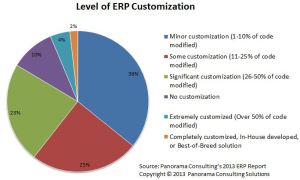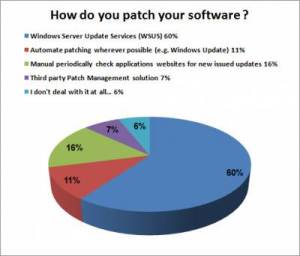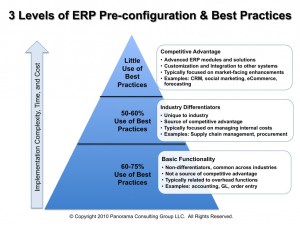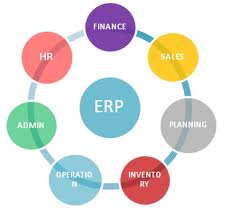According to Suresh et.al (2009) Standard ERP systems are also called vanilla ERPs that are designed to function adequately, as well as avoid extensive expense to implement individual components of such a system. Organisations normally want a system that works exactly for them, but it’s not commonly apparent at the cost and size a customisation project is, until it is too late. The decision makers will need to determine if customisation of the ERP systems will be required or will they change their business processes and rule to fit into the ERP system.
Fig 4.1 Level of ERP customization
Risks of customising ERP
Sharma et.al (2012) states that customisation of the system means that individual components are modified to perform in a different manner to what was first intended. In doing so, this may cause some quite serious issues. For instance, some vendors may not support customisation, and stop providing support to an organisation if they choose to customise; without a vendor, maintaining an ERP becomes a more troublesome task. Changing the core system to fit within the business processes can affect the functionality requirements and result in re-coding the changes at each upgrade, or foregoing the upgrade and missing out on the improvements that it may bring. This will not fix or solve the problem and could lead to ERP implementation failure. However, most companies want to keep their business processes with minimal changes and ask the ERP vendor to customize its software. Customisation of an ERP is a very extensive project, and should never be taken on lightly. The expenses, and so forth are usually out of reach of smaller organisations, and mistakes made by larger organisations can bring them to financial ruin. Some of the risks that may arise due to customisation are:
- Higher resourcing and associated costs.
- Ability to upgrade to future releases will be affected.
- Supporting agreements can be affected.
- Functionality problems.
- Time consuming.
Video 4.2 ERP customization kills innovation
Business process re-engineering (BPR)
According to Suresh et.al (2009) business Process Re-engineering is a strategy many companies use in reviewing the way they perform their business activities. For example in the past one must go to the bank to perform their banking and paying of bills, through BPR clients can now perform this task through phone and internet banking.
References:
Ng, J, Ip, W & Lee, T 1999, ‘A paradigm for ERP and BPR integration’, International Journal of Production Research, vol. 37, no. 9, pp. 199-210.
Sharma, R, Patel, S & Tendon, A 2012, ‘Customization and best practices model for adopting ERP systems: an analysis’ , International Journal of Business Strategy, vol. 12, no. 1, pp. 1-9.
Suresh, S, Mohamed, T & K.V, K 2009, ‘The Role of BPR in the Implementation of ERP systems’ ,Business Process Management, vol. 15, no. 5, pp. 653-668.
Assessment Item 2 (report)
The purpose of this assignment is to provide a report responding to the case study. You should make clear what the problem is and also outline what the options are. The report will consist of the following sections:
Executive Summary
It will summarize any issues or problems faced by the implementation team, any background information to the problems, any methods or strategies used, any issues that arises due to poor planning, schedules not being met or over spending of the allocated budgets. The executive summary will suggest recommendation in moving forwards as a result from the discussion and findings.
Introduction
It will introduce the report through its purpose and the method used in presenting the report. It will also introduce the scope of the report but it will be elaborated further during the report.
Detailed discussion about the report
It is the main body of report that will explains and analyse the findings. All of the requirements are discussed alongside with the processes of the business and their collaboration with the ERP system. It will also discuss about decisions and their impacts to the ERP system by introducing risks and change management to the production line. It can also discuss the current model and procedures and state reasons why it is appropriate to stay with the current system or to implement a new system altogether.
Recommendations
It will be on the best options available by presenting the benefits and risks associated with them.
Conclusion
This part will discuss all of the facts and summarize the report findings.
References
This part will include the detailed references list used in the report.




